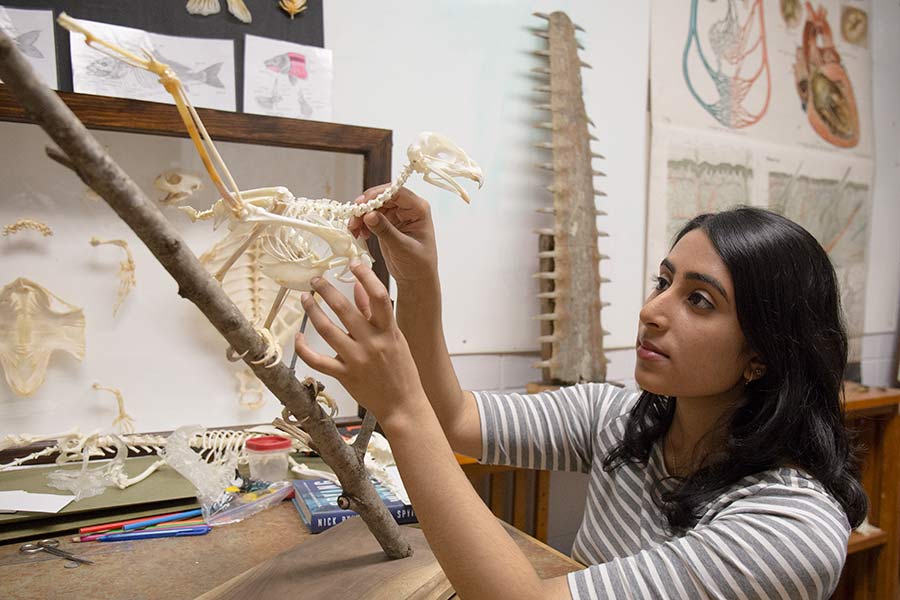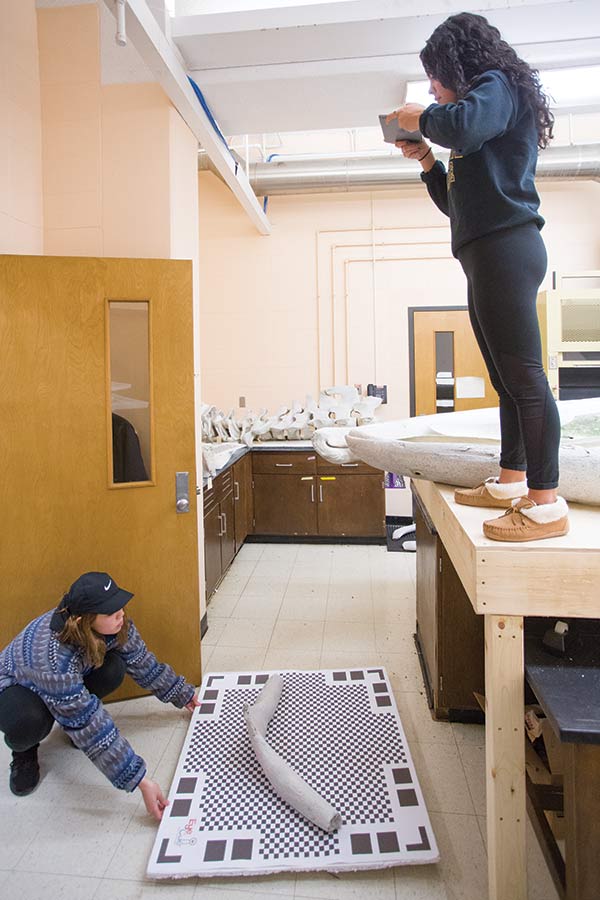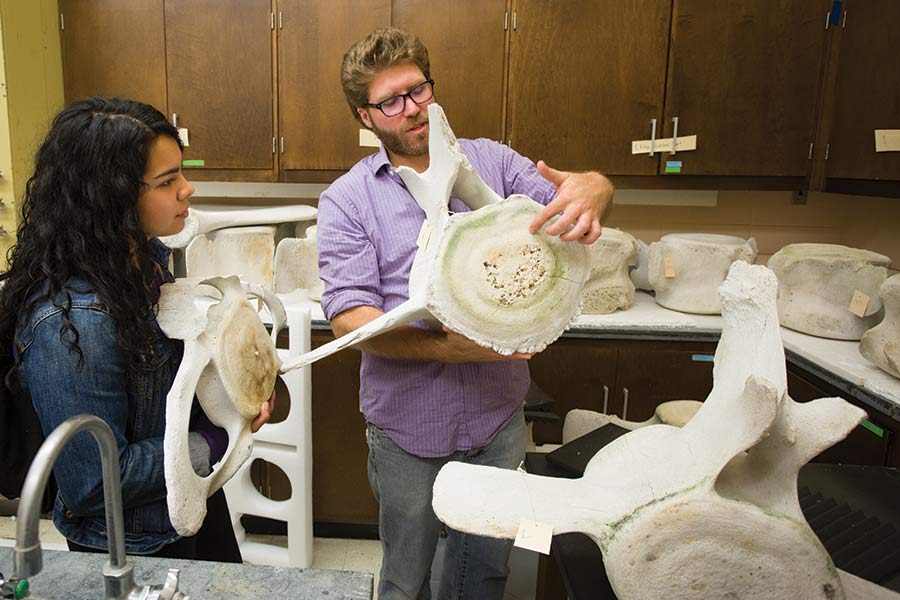Junior Emily McParland takes measurements of a whale vertebrae. Photo by Peter Bailley '74
When the first phase of renovations to Knox’s Umbeck Science-Mathematics Center is completed this fall, along with the new science commons and classrooms, it will include a new two-story atrium facing campus that will be home to Knox’s largest resident—a 55-foot fin whale skeleton.
The skeleton came to Knox thanks to the efforts of Assistant Professor of Biology Nicholas Gidmark. Procuring the whale wasn’t easy. (Find out how a whale came to Knox.) But Gidmark’s biggest challenge has been preparing the whale for display. Luckily, he’s had assistance from a group uniquely qualified to help—his students in BIOLOGY 325: Comparative Vertebrate Anatomy. Over the last year, these students have been identifying, cleaning, imaging, and repairing the bones. Much of the knowledge and confidence the students are bringing to the project comes from that fall term anatomy class, and they are learning additional skills through research and trial and error.
Though Comparative Vertebrate Anatomy has been taught for many years at Knox, Gidmark’s research interest in examining animal form and function using the lenses of comparative anatomy, muscle physiology, and biomechanics made him the perfect fit to teach the class when he joined the faculty three years ago. After his first term at the helm, he changed the structure of the class from three days of lectures and one day of lab each week to two days of lectures and two days of labs. “To get into something, you really need to have your hands on it,” said Gidmark. “And by doubling our lab time, we could get through the labs we had been doing much more quickly.”
With the extra lab time, Gidmark was able to add one final project to the course—a skeletal articulation. The class was divided into eight teams of three students, and each team was given a box that contained the bones of animals Gidmark had obtained and cleaned prior to the start of the term— of a fox, opossum, hawk, owl, seagull, dog, dolphin, or seal. For the rest of the term, their assignment was to identify the bones and reassemble the skeletons.
Megan Koluch ’19, whose future plans include medical school, was on the team that assembled the dolphin. “I was handed that box of bones and thought ‘I know nothing,’ and freaked out for a minute. And then it’s like ‘Oh, I know this is a cervical vertebra,’ and just kind of started piecing together everything I’d learned.”
Once the bones were identified, they were reassembled into a lifelike posture. The fox is jumping, the dolphin is diving, the dog is sitting. “For this project, they not only had to think about how the bones are connected, but how the animal moves,” says Gidmark. They’re integrating animal locomotion, animal behavior, and animal posture, as well as just raw anatomy.”
The students drilled holes into each individual bone, then threaded them to each other using rods for larger animals like the seal or dog (which was the size of a Great Dane), or fine wire for the delicate bones of the hawk, owl, and seagull. Once in position, the hundreds of bones were glued to hold their pose, creating a museum-quality articulation. “They spent a lot of time with the fine details so that you don’t see how, say, the leg is connected. It’s just connected,” says Gidmark.

He estimates each student spent more than 100 hours outside of lab time to complete their projects. For Koluch, it was the most humbling and challenging experience of her academic career. And also the most rewarding. “In the end, when you get to see your finished project and everyone is just in awe, it’s just so cool to be like, yeah, I did that.”
Koluch says that her biggest takeaway from the project is that no matter how perfectly plans are laid out on paper, it’s not necessarily going to work out that way in real life. “You just have to keep working through those problems and find solutions for them. There’s no manual for these things.”
Gidmark says that tenacity and the ability to work though the problem have been huge assets as he and his team of students have tackled the whale articulation project. “The logistics are difficult to grasp unless you’ve done something on a smaller scale,” says Gidmark.
Just like the class articulation, the first step in the whale project involved identifying the bones. Students were assigned different sections of the anatomy, such as the ribs, skull, flippers, and vertebrae.

Once the bones were identified, each was placed on a three-foot turntable, and, while one student slowly turned it, another took multiple photos from different angles. These were used to make three-dimensional (3D) images of each bone. Students then created a 3D animation of the whale.
Sydney Fretwell ’19, who plans to attend veterinary school, worked on the computer animation. “Once it’s finished, we’ll be able to see how it articulates. If we move the tail upwards, the whole verticular column is going to move with it.”
A 3D model of the atrium is helping the team determine the appropriate articulation of the whale for the space. “There’s going to be a two-inch pipe that goes through all of the vertebrae that will need to be professionally bent, so we need to know exactly what we want before it’s hung,” says Gidmark.
In addition to the scanning and animation of the whale, another component of the project that was new for the team was the cleaning, repairing, and even re-creation of some of the bones.
Because the bones were exposed to the elements for years before coming to Knox, they were discolored and covered in dirt and algae. Sam Arrez ’19, who plans to attend medical school, worked with other students over winter term to clean the bones. “It was a lot of trial and error. We started off with hydrogen peroxide and a stain-removing powder. We had to figure out things like if it was better to soak the bones in a solution or rinse them. Or what works better, a toothbrush or scraper?” When they completed the cleaning process, the team coated the bones in a liquid polymer to strengthen them.
Some of the bones were damaged or broken and had become porous from exposure. In some cases, the smaller finger bones (yes, whales have fingers) were missing entirely. The team used the College’s 3D printer to re-create smaller bones. To repair some of the larger ones, Assistant Professor of Art Andrea Ferrigno has been working with Gidmark to sculpt missing sections of vertebrae. And she’s been working with students to develop the best way to repair cracks and other deformities.
Jini John ’19 is headed to optometry school this fall and enjoys specialized detail work. During spring term, she used a combination of resin and microballoons to fill bone deformities, layering and sanding multiple times to achieve a natural look. “If you pile a lot on, it’s going to bubble up and look plaster-like,” which is why John’s steady hand and eye for detail has been such an asset to the project. “In the end, you want it to look like bone, not artificial.”
Once the bones were cleaned and repaired, the last step was to paint all of the bones to give them a uniform look.

This summer, Gidmark and students are putting the whale together in 10-foot sections, with plans to have the whale articulated and hanging in the atrium by Homecoming weekend.
“I often waffle between being so humbled and amazed and honored to be part of this incredible project, and kind of angry at myself at biting off such a big project,” says Gidmark. “So whose idea was this? Oh yeah, it was mine. Totally mine.”
He says that for his students, “learning how to actually connect a chevron bone to a vertebra is not really that transferable, I’ll give you that. There are not that many jobs out there that need that skill. But it’s those softer skills of planning, and work, and thought, and the fact that they really do pay off—you can’t do it without those tools.”
And while Gidmark and his students continue their work in the biology wing of the Umbeck ScienceMathematics Center, he can’t help but look to the future. “Twenty years from now, that whale is going to be hanging there, and the alumni who put it together are going to come back, and they’re going to remember. And they’ll go find the dog or seal or hawk and they’ll still be here. We did this together, and it was a crazy amount of work. And it was wonderful.”